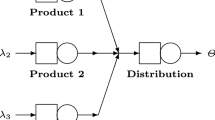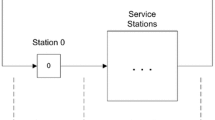Abstract
Given a series-parallel queueing network topology with exponential servers of finite capacity, a systematic design methodology is presented that approximately solves the optimal routing and buffer space allocation problems within the network. The multi-objective stochastic nonlinear programming problem in integer variables is described and a two-stage iterative optimization procedure is presented which interconnects the routing and buffer space allocation problems. The algorithmic procedure couples the Expansion method, a decomposition method for computing performance measures in queueing networks with finite capacity, along with Powell's unconstrained optimization procedure which allocates the buffers and a multi-variable search procedure for determining the routing probabilities. The effectiveness and efficiency of the resulting two-stage design methodology is tested and evaluated in a series of experimental designs along with simulations of the network topologies.
Similar content being viewed by others
References
Altiok, T. (1982). “Approximate Analysis of Exponential Tandem Queues with Blocking.” European Journal of Operations Research 11, 390–398.
Altiok, T. and S. Stidham. (1983). “The Allocation of Interstage Buffer Capacities in Production Lines.” IIE Transactions 15(4), 292–299.
Altiok, T. and H.G. Perros. (1986). “Open Networks of Queues with Blocking: Split and Merge Configurations.” AIIE Transactions, 251-261.
Baccelli, F. and S. Foss. (1995). “On the Saturation Rule for the Stability of Queues.” J. Applied Probability 32, 494–507.
Basnet C. and J.H. Mize. (1994). “Scheduling and Control of Flexible Manufacturing Systems: A Critical Review.” International J. of Computer Integrated Manufacturing 7(6), 340–355.
Bertsekas D. and R. Gallagher. (1987). Data Networks. Englewood Cliffs, NJ: Prentice-Hall.
Boxma, O. and A. Konheim. (1981). “Approximate Analysis of Exponential Queuing Systems with Blocking.” Acta Informatica 15, 19–26.
Buzacott, J. (1967). “Automatic Transfer Lines with Buffer Stocks.” Int. J. of Prod. Research 5(3), 183–200.
Buzacott, J. (1971). “The Role of Inventory Banks in Flow-Line Production Systems.” Int. J. of Prod. Research 9(4), 425–436.
Buzacott, J. and J.G. Shanthikumar. (1993). Stochastic Models of Manufacturing Systems. Englewood Cliffs, NJ: Prentice-Hall.
Buzacott, J., J.G. Shanthikumar, and D.D. Yao. (1994). “Jackson Network Models of Manufacturing Systems.” In D.D. Yao (ed.), Stochastic Modeling and Analysis of Manufacturing Systems. New York: Springer, pp. 1–45.
Cassandras, C. (1984). “A Hierarchical Routing Control Scheme for MHS.” In Proceedings of ORSA/TIMS Conference on FMS. Ann Arbor, USA: Univ. of Michigan, pp. 397–402.
Chankong and Y.Y. Haimes. (1983). Multiobjective Decision Making: Theory and Methodology. NewYork: North-Holland.
Daskalaki, S. (1988). “Static and Real Time Routing in Open Finite Queueing Networks.” Ph.D. Dissertation, Department of Industrial Engineering and Operations Research, University of Massachusetts, Amherst, MA.
Daskalaki, S. and J. MacGregor Smith. (1986). “The Static Routing Problem in Open Finite Queueing Networks.” Paper presented at the ORSA/TIMS Meeting, Miami, FL, October 1986.
Daskalaki, S. and J. MacGregor Smith. (1989). “Real Time Routing in Finite Queueing Networks.” In H.G. Perros and T. Altiok (eds.), Queueing Networks with Blocking. Amsterdam: North-Holland, pp. 313–324.
Enginarlar, E., J. Li, S.M. Meerkov, and R.Q. Zhang. (2002). “Buffer Capacity for Accomodating Machine Downtime in Serial Production Lines.” Int. J. of Prod. Research 40(3), 601–624.
Gavish, B. (1982). “Topological Design of Centralized Computer Networks: Formulations and Algorithms.” Networks 12(4), 355–377.
Gavish, B. (1983). “Formulations and Algorithms for the Capacitated Minimal Directed Tree Problem.” J. ACM 30(1), 118–132.
Gavish, B. (1986). “A General Model for Topological Design of Computer Networks.” In Proceedings of GLOBECOM '86.
Gavish, B. and I. Neuman. (1986). “Capacity and Flow Assignments in Large Computer Networks.” In Proceedings of IEEE-INFOCOM '86, pp. 275-284.
Gershwin, S.B. (1984). “An Efficient Decomposition Method for the Approximate Evaluation of Production Lines with Finite Storage Spacer.” In Sixth INRIA Conference Proceedings. Nice, France.
Gershwin, S.B. (1986). “Modelling and Analysis of Assembly/Disassembly Networks.” In IEEE Proceedings Systems, Man, and Cybernetics Conference, October 1986.
Gershwin, S.B. (1987). “An Efficient Decomposition Method for the Approximate Evaluation of Tandem Queues with Finite Storage Space and Blocking.” Operations Research 35, 291–305.
Gershwin, S.B. and J.E. Schor. (2000). “Efficient Algorithms for Buffer Space Allocation.” Annals of Operations Research 93, 117–144.
Gosavi, H. and J. MacGregor Smith. (1995). “Asymptotic Bounds of Throughput in Open Finite Queueing Networks.” Computers and Operations Research 22(10), 1057–1073.
Gosavi, H. and J. MacGregor Smith. (1997). “An Algorithm for Sub-Optimal Routing in Series Parallel Queueing Networks.” Int. J. of Prod. Research 35(5), 1413–1430.
Hillier, F.S. and R.W. Boling. (1967). “Finite Queues in Series Exponential or Erlang Service Times-A Numerical Approach.” Operations Research 15, 286–303.
Houck, D.J. (1987). “Comparison of Policies for Routing Customers to Parallel Queueing Systems.” Operations Research 35(2), 306–310.
Huang M.G., P.L. Chang, and Y.C. Chou. (2002). “Buffer Allocation in Flow-Shop-Type Production Systems with General Arrival and Service Patterns.” Computers & Operations Research 29(2), 103–121.
Kelly, F.P. (1990). “Routing and Capacity Allocation in Networks with Trunk Reservations.” Mathematics of Operations Research 15(4), 771–793.
Kerbache, L. and J. MacGregor Smith. (1987). “Asymptotic Behavior of the Expansion Method for Open Finite Queueing Networks.” Computers and Operations Research 15(2), 157–169.
Koenigsberg, E. (1959). “Production Lines and Internal Storage-A Review.” Management Science 5, 419–433.
Landers, R.G., B.K. Min, and Y. Koren. (2001). “Reconfigurable Machine Tools.” Annals of CIRP 50(1), 269–274.
MacGregor Smith, J. and S. Daskalaki. (1988). “Buffer Space Allocation in Automated Assembly Lines.” Operations Research 36(2), 343–358.
MacGregor Smith, J., S.B. Gershwin, and C.T. Papadopoulos (eds.). (2000). Performance Evaluation and Optimization of Production Lines. Annals of Operations Research, Vol. 93. Baltzer Science Publishers.
Neufeld, E.M. and C.J. Colbourn. (1985). “The Most Reliable Series-Parallel Networks.” Networks 15, 27–32.
Papadopoulos, H.T. and M.I. Vidalis. (2001). “A Heuristic Algorithm for the Buffer Allocation in Unreliable Unbalanced Production Lines.” Computers & Industrial Engineering 41, 261–277.
Perros, H.G. (1994). Queueing Networks with Blocking. New York: Oxford University Press.
Pollock, S., J.R. Birge, and J.M. Alden. (1985). “Approximation Analysis for Open Tandem Queues with Blocking: Exponential and General Service Distribution.” Technical Report 85-30, Department of Industrial & Operations Engineering, University of Michigan, Ann Arbor, MI 48109.
Powell, M.J.D. (1964). “An Efficient Method for Finding the Minimum of a Function of Several Variables without Calculating Derivatives.” Computer Journal 7, 155–162.
Singh, A. and J. MacGregor Smith. (1997). “Buffer Allocation for an Integer Nonlinear Network Design Problem.” Computers & Operations Research 24(5), 453–472.
Spicer, P., Y. Koren, M. Shpitalni, and D. Yip-Hoi. (2002). “Design Principles for Machining System Configurations,” Annals of the CIRP51(1).
Spinellis, D., C. Papadopoulos, and J.M. Smith. (2000). “Large Production Line Optimization Using Simulated Annealing.” International Journal of Production Research38(3).
Takahashi, Y., H. Miyahara, and T. Hasegawa. (1980). “An Approximation Method for Open Restricted Queueing Networks.” Operations Research 28(3), Part I, 594–602.
Yao, D. (1984). “A FMS NetworkModel with State-Dependent Routing.” In Proceedings of the ORSA/TIMS Meeting on FMS. Ann Arbor, USA: Univ. of Michigan.
Author information
Authors and Affiliations
Rights and permissions
About this article
Cite this article
Daskalaki, S., MacGregor Smith, J. Combining Routing and Buffer Allocation Problems in Series-Parallel Queueing Networks. Annals of Operations Research 125, 47–68 (2004). https://doi.org/10.1023/B:ANOR.0000011185.77227.ae
Issue Date:
DOI: https://doi.org/10.1023/B:ANOR.0000011185.77227.ae




